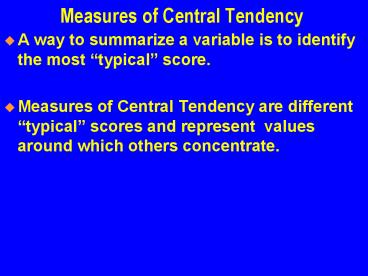Measures of Central Tendency PowerPoint PPT Presentation
1 / 29
Title: Measures of Central Tendency
1
Measures of Central Tendency
- A way to summarize a variable is to identify the
most typical score. - Measures of Central Tendency are different
typical scores and represent values around
which others concentrate.
2
The Mode
- The mode is the value with the highest frequency
count. - While the mode can be useful, it is very
informative as it only tells us which value
occurred the most frequently.
3
The Median
- The median that marks the midpoint. ½ of the
values exceed the median and ½ of the values are
below the median. - The median is better than the mode in summarizing
a variable, but tells us little about the
distribution of values.
4
The Mean
- The mean incorporates all of the values for a
variable! Called the average, it is obtained
by adding up all the values dividing that sum
by the total number of cases. - Usually the most accurate, stable and useful
measure of central tendency.it is vulnerable to
distortions by extremely high or low values.
5
Measures of variability
- A quick measure of variability is the range. To
calculate the range (R) you subtract the lowest
value (L) for a variable from the highest value
(H). - Although better than nothing, it is based only on
the two most extreme variable scores.and ignores
all the other information about the dispersion in
the data. - The variance reflects the sum of deviations of
each value from the mean and provide us with an
average amount of dispersion or variability.
The standard deviation is the square root of the
variance.
6
(No Transcript)
7
From descriptive to inferential statistics.
- The normal distribution and z-scores connect
descriptive statistics to inferential statistics. - The ND adds to the interpretation of the mean and
standard deviation, and is the basis for
statistical estimation, hypothesis testing, and
measures of association.
8
(No Transcript)
9
Why is the normal curve so important in
statistics?
- A large number of real world variables are
normally distributed. - The sampling distribution of several statistics
are normally distributed. - The above theorems are why researchers can make
accurate inferences about populations from the
analysis of samples. They can accurately
estimate population parameters using sample
statistics.
10
Key aspects of the normal curve
- The normal curve is symmetrical or bell-shaped.
- The mean is also the most frequently occurring
value (the mode), and the value that splits the
distribution in half (the median). - Assuming a variable is normally distributed in
the population, we can say much more about the
standard deviation.
11
(No Transcript)
12
From Statistical Estimation to Confidence
Intervals.
- Probability theory states that in repeated
sampling, the distribution of sample means will
be normally distributed with a mean equal to the
true population mean. - Thus, we can define a range of values within
which the true population mean is likely to be. - And we can estimate the probability that our
range includes the population meanwhen we do
this we have calculated a confidence interval.
13
(No Transcript)
14
(No Transcript)
15
(No Transcript)
16
(No Transcript)
17
(No Transcript)
18
Hypothesis Testing t-tests
- If we are interested in seeing if the means or
proportions of a variable differ between two
groups, the t-ratio or t-test is our statistic of
choice.
19
(No Transcript)
20
(No Transcript)
21
Hypothesis Testing ANOVA
- If you are asked to look for significant
differences in the means of three or more groups
your method of choice is analysis of variance
(ANOVA). - SSt Total Sum of Squares Total Variation in
the data. - SSb Between Group Sum of Squares Between
group variation in the data. - SSw Within Group Sum of Squares Within group
variation in the data. - The F-ratio represents the size of the
differences between the groups we are comparing
relative to the size of the differences within
the groups we are comparing.
22
(No Transcript)
23
Hypothesis Testing Chi-square
- When you are testing for differences with
variables at the nominal or ordinal level, the
Chi-square statistic is appropriate. - Chi-square tests if the difference between
observed frequencies (fo) and expected
frequencies (fe) is so large it cannot be due to
chance or random sampling error.
24
(No Transcript)
25
(No Transcript)
26
(No Transcript)
27
(No Transcript)
28
(No Transcript)
29
CORRELATION REGRESSION
- The higher the correlation between X and Y, the
better our predictions of Y using X will be. - The value r² measures how much better our
predictions of Y using X are.if we square
Pearsons r .85, we obtain r² .72. This is
the coefficient of determination and means that
if we use X to predict Y we will improve the
accuracy of our predictions by 72. - The coefficient of non-determination is 1- r²,
and it is the percentage of variability in Y not
explained by X (due to other causal variables).

